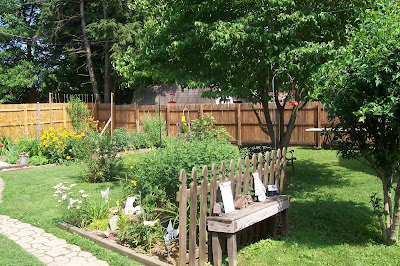I've sloughed off as far as updating the blog.
Let's pick it up again, somewhat. I finished the attic deck, putting down the rest of the OSB flooring. I then had the concrete poured in the garage area. It was done by the O'Neal "boys" (son and father). But, I think their real names are Jack and Jake Leg. What a joke, but we won't go there. I am not happy with it, but am resigned to learning how to live with permanent swirls in the garage floor. True, their power trowel went belly-up and it was humid, plus the late evening thunder storm didn't help, but still, sheesh!
Valuable lesson - just because they have a business card doesn't mean they know the business.
The weather has been a real detriment on what is basically a one-man show. Plus the grass has to be cut, laundry done (I do my own stuff, I just prefer it that way), the garden had to be put out, dogs to the vet, grocery shopping (yes, I'm the designated grocery guy), dental appointments, plus I'm not real fast. It's just my nature. Slow and steady will get there.
I really didn't get back to it until the end of April, too darned wet around here to do any work outside. May was productive with all the OSB going on the walls, but June was basically a washout. July was good and I got a good start of the
gambrel rafters. 2x6 chords and 3/4" plywood gussets, and each also has an 8 foot 2x4 collar tie and they're attached to the 2x6 plate with two 16d nails and also Simpson hurricane ties. I run 3/4" bracing along the chords and collar ties to tie them all together. The OSB roofing deck and the gable end framing will ensure a solid roof securely attached to the building.
It took me about a day and a half to figure it all out and make the first test set - the light bulb finally came on when I realized that a completed rafter covers 180 degrees and there were 8 angles total. 180 divided by 8? 22.5 of course. Funny thing is at 20' wide and 10 total height, the top chords are 3/8" shorter than the bottom chords. I still haven't figured that one out, but it works, that's what matters. Also, I've used Turbo Cad software thru out this endeavor and that is a BIG help, using the computer to see what works and what doesn't.
April through June was very wet, July and August have been one of the hottest and most humid I've experienced in some time around here. Miserable hot and humid. I get about 2 or 3 hours total work on days like that.
Also, besides being slow, I'm anal. Every piece of exposed lumber has a coat of Olympic deck sealer, which in hindsight I realize only slows the process down more. But I hate seeing my lumber get wet, the water sealing process slows me down, but I look at it as a justifiable tradeoff as it just pains me to see wet lumber, especially at the price you have to pay for it nowadays.
I've now got all the rafters made. Only 4 left to install and they're assembled and temporarily braced at the end as I've run out of room to maneuver and will have to slide them into place. Mrs A.G.T. helped me get the first 2 in place and the last gable end one, but she is not comfortable working at height, so I devised a "gantry" and rigged a block/tackle to it and put the other rafters up. It was interesting, but towards the end I got pretty darned good at it.
Here's more:
Here's an
end shot of the gambrels from the ground.
That's all 19 of them (24" o.c.) but I ran out of manuever room on the far end and have the
4 remaining ones temporarily attached to #15.
The last one only has gussets on the inside as it is one of the two gable end rafters and you leave the outer gusset off since you'll do gable end framing and attach OSB wall sheathing to them.
Here's a
closer look at the knuckles and 3/4" plywood gussets. There's 16" on each "leg" or 32" wide per gusset, that's the most economical way to use at 4 x 8 sheet of plywood and still be pretty confident that you've got a strong joint.
There's construction adhesive on each side, 2" galvanized deck screws, and 8d ring-shank nails to attach the gussets to the 2 x 6 chords. Plus that 2 x 4 x 8 collar tie will help keep the whole setup very rigid.
The first gusset cut from your plywood will be deeper then the others. You'll have 3 of those per sheet of plywood so I used them on one side of the
ridge knuckle of each gambrel.
I used a
jig of 2x6 scrap screwed thru the deck into the floor joists to hold the pieces while they were screwed, nailed, and adhesived.
I attached them to the bottom "plate" with a combination of
Simpson Strong-ties and 3 16d nails nailed into a 2x6 block on the other side. It should stay in place regardless of any normal uplift from the winds we get around here.
Here's the
homemade rig that I used to lift them up off the deck along with a block & tackle.



